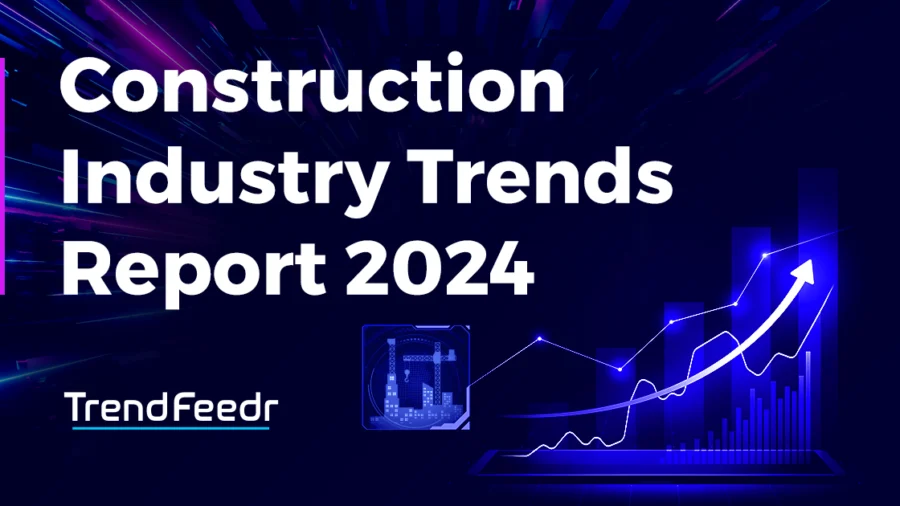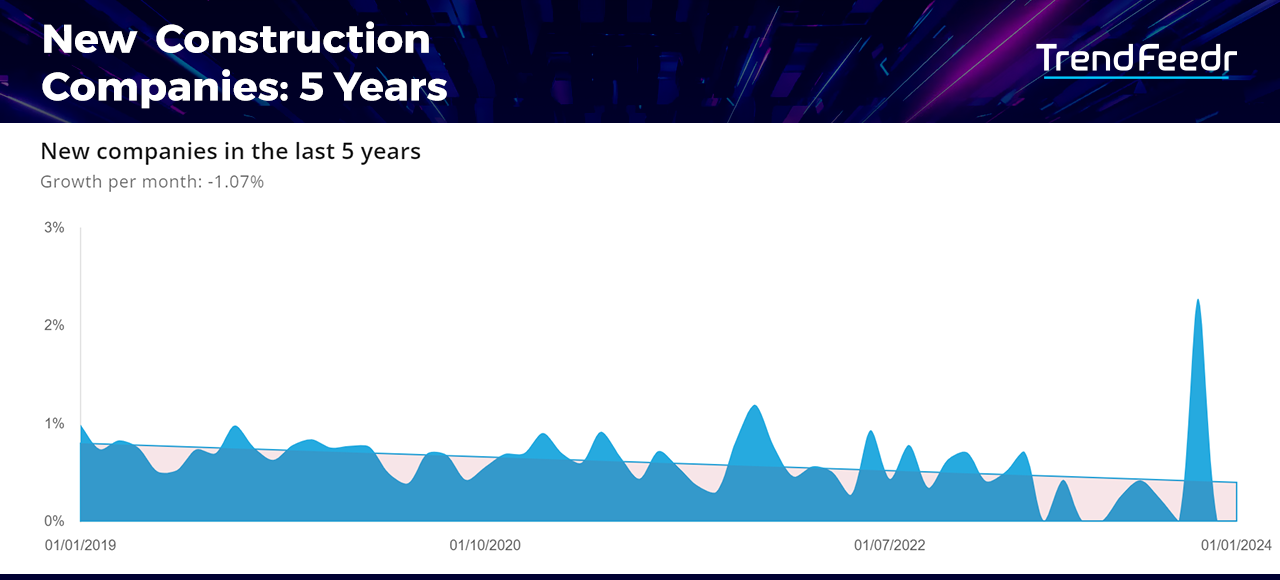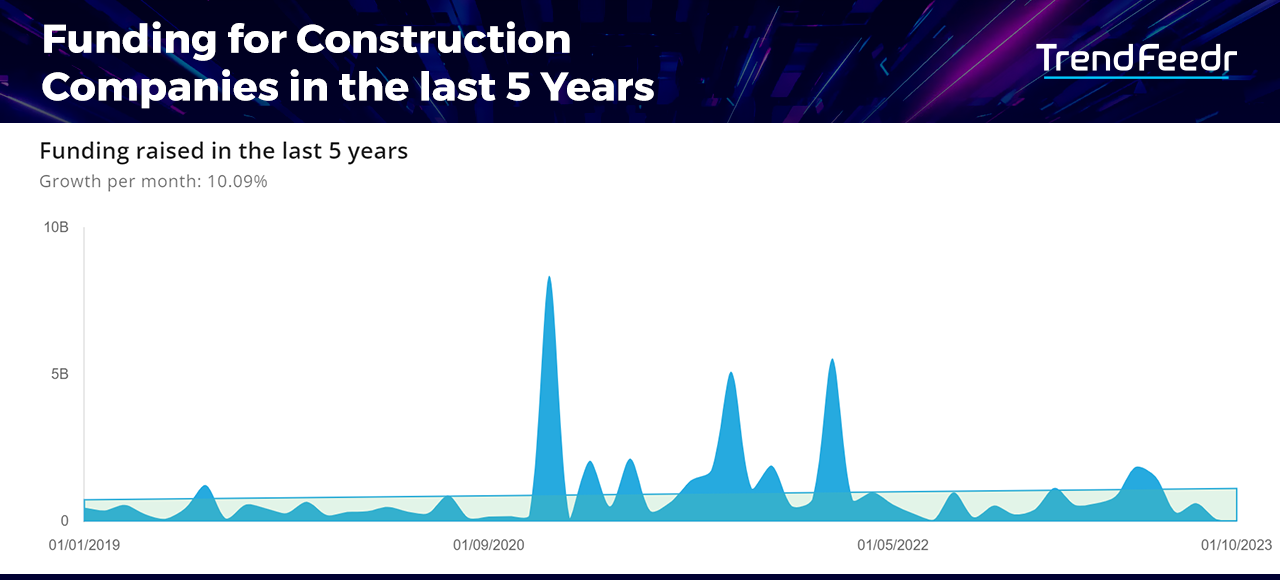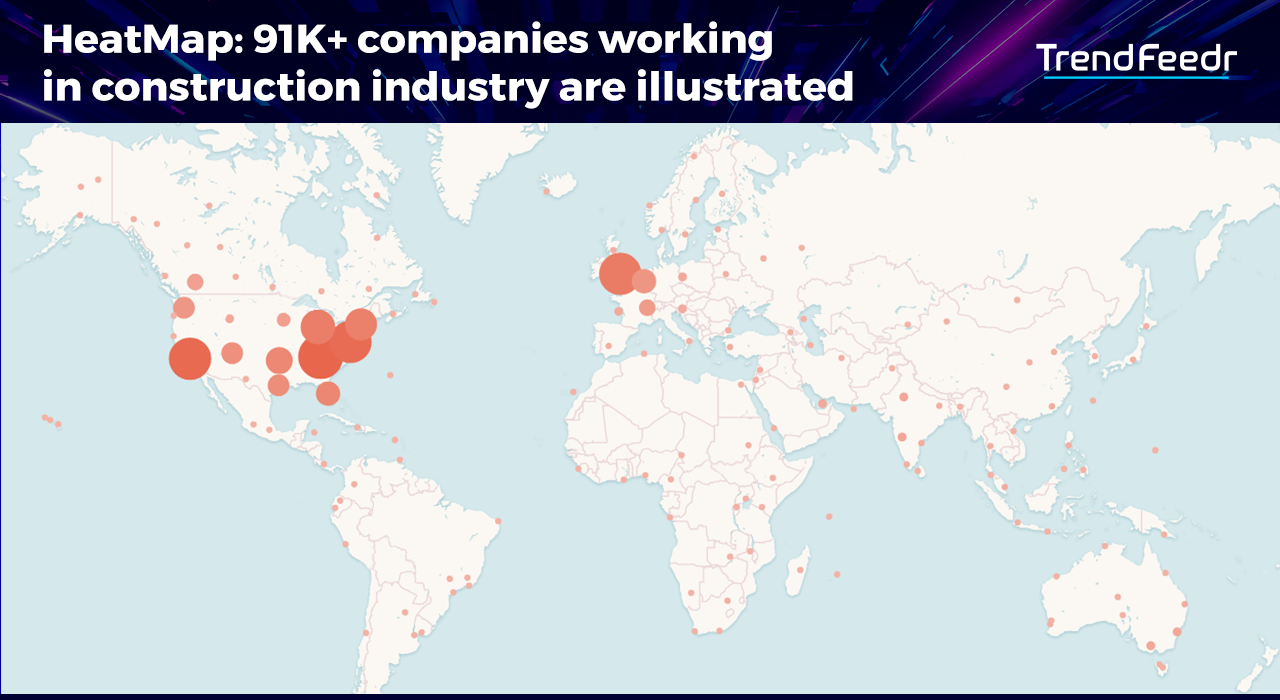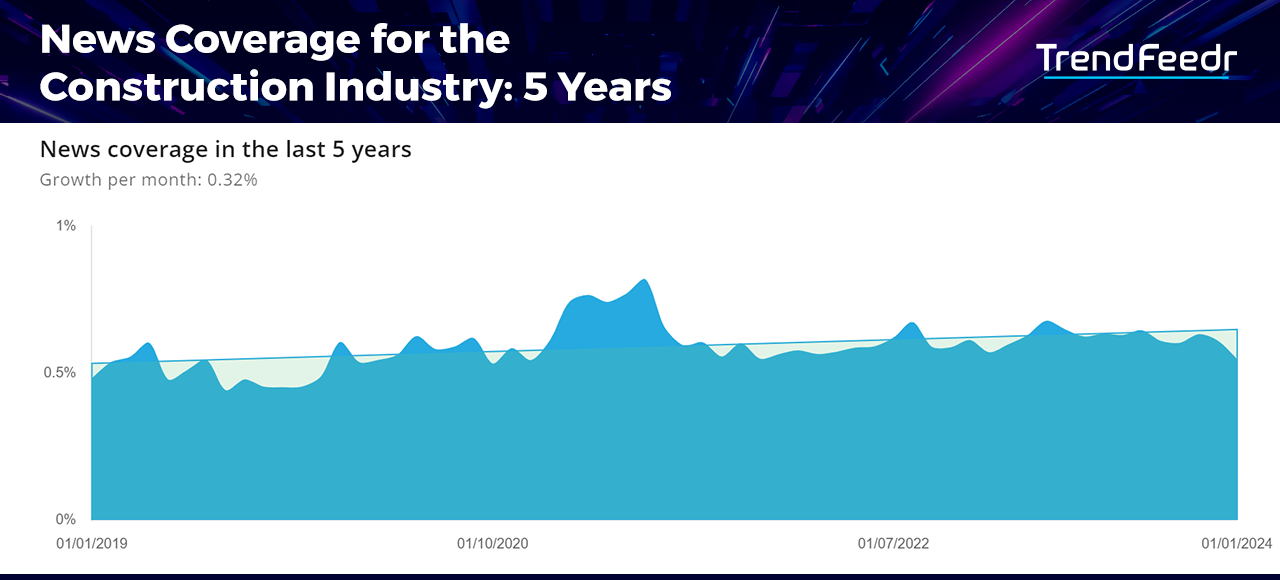The construction sector is emerging as a hub of innovative technologies and inventive solutions. This construction industry trends report delves into the advancements transforming urban landscapes and skylines. The emerging trends in construction include digital twins, building information modeling (BIM), sustainability, robotics, and modular construction.
The construction industry is demonstrating improved efficiency, sustainability, and adaptability to the rapidly changing global environment. The incorporation of BIM enhances the planning and execution phases of construction projects. Moreover, adopting sustainable materials and green construction practices is gaining momentum. Construction firms are also utilizing environmentally friendly resources such as recycled steel and bamboo. Energy-efficient structures also reduce environmental impact. The industry’s dedication to technology-driven urban development is further reflected in the growing number of smart city projects.
According to a report by Statista, the global construction industry’s revenue is on a steady growth trajectory. The industry’s market size, which stood at US$6.4 trillion in 2020, is projected to reach US$14.4 trillion by 2030, effectively doubling in a decade. This construction market trend underscores the robust expansion and adaptability of the sector amidst global economic and environmental changes.
Key Takeaways
- Revolutionizing Trend: With a trend magnitude of 99.58% and a maturity of 81.47%, according to TrendFeedr, the construction industry is adopting new technologies and sustainable practices, showing a commitment to innovation and the environment.
- Technological Advancements in Construction: Construction firms are broadening their scope to incorporate technology trends such as digital twins, BIM, green construction, robotics, and modular construction.
- Growing Media Spotlight: The industry has seen a steady monthly growth of 0.32% in news coverage over the past five years. This highlights its dynamic nature and escalating influence on global infrastructure evolution.
- Organizational Landscape & Investment: Approximately 91,000 entities are actively engaged in construction, collectively drawing investment capital of around US$1.6 trillion.
- Major Investors such as Tiger Global Management, Comvest Partners, and Wells Fargo are injecting millions into innovative construction initiatives.
- Global Reach and Influence: The United States, Germany, the United Kingdom, Canada, and Australia are leading nations in the construction industry. Key cities like London, New York City, Sydney, Houston, and Melbourne are also emerging as epicenters of construction innovation.
Table of Contents
- Understanding Construction Industry Trends
- Construction Trend Card
- 5 Key Construction Industry Trends
- Emerging Trends and Technologies Disrupting the Construction Industry
- 5 Emerging Construction Companies
- Construction Investment Trends
- Mapping Global Construction Companies
- Media Coverage for the Construction Industry
- Future of Construction
For this detailed analysis of material trends, we use TrendFeedr, our all-in-one trend intelligence platform. TrendFeedr uses advanced algorithms to identify future industry and tech trends. With a focus on trend discovery, clustering, and analysis, the AI-powered platform reviews thousands of trends each week to provide actionable insights.
Among more than 20,000 trends and technologies monitored by TrendFeedr, construction has made a significant impact. Here’s why:
- The construction industry is listed among the top 100 trends and ranks within the top 1% of global trends. It is driving economic growth and setting up critical infrastructure across various sectors.
- With a maturity score of 81.47%, the construction trend distinguishes itself, primarily fueled by the initiatives and breakthroughs of established industry front-runners.
- This sector holds a crucial role in molding urban landscapes, contributing to technological progress, and promoting sustainable development. In doing so, it ensures resilience and efficiency in the built environment.
This construction industry trends report further explores performance, investment, regional, and future outlook.
Understanding Construction Industry Trends
A variety of new trends are redefining the conceptualization, planning, and execution of projects in the construction industry.
What are the latest trends in the construction industry?
The industry is witnessing a growing emphasis on sustainable construction, leading to an increased use of eco-friendly materials and the adoption of green building practices. This trend mirrors a wider societal shift towards environmental responsibility.
Following this, the industry is embracing modular and prefabricated construction. This approach is gaining popularity due to its efficiency and the ability to reduce on-site construction time. It involves the off-site construction of building components, which are then assembled at the final location.
As the global population gravitates towards urban areas, the construction industry is playing a crucial role in urbanization and smart city projects. These projects leverage technology to enhance livability and sustainability.
Lastly, big data and construction analytics are the other significant trends. Data analytics solutions enable predictive modeling and optimize various facets of construction projects, ranging from material usage to manpower allocation.
What are various construction technologies?
BIM, with its 3D modeling and real-time collaboration capabilities, provides architects, engineers, and contractors with a comprehensive visualization of projects, thereby minimizing errors and conserving resources. 3D printing in construction is utilized to fabricate intricate building components and even entire structures. This unlocks new avenues in design and material application.
Further, construction companies leverage drones for surveying and monitoring project sites as well as ensuring adherence to plans. Simultaneously, robotics are increasingly harnessed for repetitive tasks, thereby enhancing precision and efficiency.
Augmented reality (AR) and virtual reality (VR) are also employed for project visualization and design alterations. They offer immersive walkthroughs for clients or stakeholders. Lastly, AI and machine learning enable predictive maintenance and risk management.
Construction Trend Card: The Most Recent Developments
Our Construction Trend Card offers an in-depth look at the sector’s performance, key patterns, and metrics:
Looking for all trends related to construction?
- Sector Overview: The construction industry, with a total of 91,194 companies worldwide, demonstrates its substantial influence and critical role in the global market.
- Trend Growth: The industry exhibits a trend magnitude of 99.58%, indicating extensive activity and interest in this sector. However, there’s been a decline (-61.42%) in trend growth over the past five years.
- Media Visibility: A significant number of news articles (784.6K) have been published about the construction industry. The annual growth of news coverage has been 8.05% in the last five years, with a monthly growth of 0.32%.
- Investment and Innovation: The sector has attracted substantial financial support, with total funding reaching US$86.1 billion. The sector has also demonstrated a commitment to innovation, as evidenced by the 11,100 patents filed.
- Workforce Dynamics: With a total workforce of 7.5 million, the construction industry is a significant employer. The industry has witnessed a total employee growth of 337.8K.
- Economic Impact: The total revenue generation of the construction industry is US$1.6 trillion, illustrating its substantial contribution to the global economy.
- Global Presence: The sector’s global reach is apparent, with the United States, the United Kingdom, and Canada being key contributors.
Join us as we reveal further insights into these metrics as our exploration of evolving construction trends progresses.
Key Construction Industry Trends & Firmographic Insights
The construction industry boasts a collective workforce of approximately 7.5 million individuals. On average, construction firms employ about 113 professionals, and the median of 23 is indicative of a propensity towards medium-sized enterprises.
In terms of yearly employment growth, the sector has witnessed an augmentation of 337,800 workers, reflecting its progressive expansion. The average annual increment of 6 employees per company denotes a prudent yet consistent approach to growth. Concurrently, the median yearly increase of 2 employees per organization implies a preference for a measured expansion strategy among many firms.
As we delve into the five trends, we present a comprehensive examination of the extent of corporate engagement, the magnitude of financial commitment, and the scale of workforce involvement. This detailed overview provides valuable insights into the dynamic landscape of the construction industry.
1. Digital Twins
- Digital twins allow for the optimization of material and energy usage, providing detailed insights into the building lifecycle, from design to demolition.
- This trend is spearheaded by 6,184 entities, attracting substantial investments totaling US$20.7 billion.
- An extensive network of 513,700 professionals is fostering advancements in construction management and operational methodologies.
2. Building Information Modeling
- The use of BIM is transforming construction processes, leading to more efficient, cost-effective, and environmentally friendly projects.
- Currently, 3,131 organizations are leveraging this technology, with a combined investment of US$1.8 billion.
- This paradigm is driven by 387,300 adept professionals, optimizing the construction workflow from conceptualization to completion.
3. Green Construction
- Sustainable or green construction focuses on creating environmentally responsible and resource-efficient structures.
- A total of 666 organizations are committed to this green initiative, supported by funding of US$927.8 million.
- The movement is championed by 55,300 individuals, contributing to the pursuit of a more sustainable and responsible future.
4. Robotic Construction
- Robots in construction introduce automation and precision to the building process, utilizing robots for tasks like bricklaying, painting, and welding.
- This trend is propelled by 310 organizations, with financial backing amounting to US$1.7 billion.
- A total of 15,200 specialists leverage advanced robotics to enhance efficiency and safety on construction sites.
5. Modular Construction
- Modular construction is altering the traditional construction landscape through the utilization of pre-engineered modules, enabling swifter and more economical project execution.
- This trend is embraced by 1,475 organizations, with a cumulative funding of US$4.3 billion.
- The workforce dedicated to this trend numbers 130,100, underscoring its escalating prominence within the industry.
How Do Emerging Trends & Technologies Disrupt the Construction Industry?
The construction industry embraces new trends and technologies, reshaping the future of building and design. These advances enhance operational efficiency as well as pave the way for more sustainable and connected global infrastructure. Let’s explore these in-depth:
1. Digital Twins
Leveraging advanced simulations and 3D models, digital twin platforms replicate physical buildings and structures in virtual environments. This enables architects and engineers to analyze and predict the performance of real-world structures through their digital counterparts. Digital twins integrate IoT data to offer real-time monitoring and maintenance predictions, enhancing building management.
For example, OQLO.ai develops an AI-powered digital twin platform for construction monitoring. It offers 360-degree photo documentation for external and internal site views, enabling site navigation, progress tracking, and plan comparison. The startup also identifies deviations early, minimizes reworks, and offers actionable insights to inform decision-making processes.
2. Building Information Modeling
BIM encompasses the creation and use of a digital representation of a building’s physical and functional characteristics. It facilitates efficient planning, design, construction, and management of buildings and infrastructure. This, in turn, enables stakeholders to visualize projects in a simulated environment, enhancing decision-making and reducing construction errors.
For instance, SmartBIM, provides a construction coordination platform that streamlines project management. The platform features real-time schedule and quantities takeoff charts, material takeoff, 4D visualization, and digital inspection books. SmartBIM thus allows construction projects to increase productivity while reducing costs.
3. Green Construction
Sustainable construction incorporates the use of eco-friendly materials and renewable energy sources to minimize environmental impact. It emphasizes the importance of efficient water and waste management systems in construction. Additionally, green buildings feature advanced ventilation and natural lighting to reduce energy consumption. This contributes to a healthier environment and offers long-term economic benefits through reduced operational costs.
Green Business Hub is a green construction startup that creates a network of eco-conscious construction businesses, facilitating sustainable practices in new builds and retrofits. The startup also promotes the construction of low-carbon, energy, and water-efficient homes. It emphasizes the importance of sustainable design and the use of low-carbon heating sources.
4. Robotic Construction
Robots in construction reduce the need for manual labor, particularly in repetitive tasks, thereby decreasing the risk of accidents. They also contribute to higher precision and quality in construction work. The integration of robotics with AI and machine learning algorithms thus allows for continuous improvement in construction techniques.
Startups like HKCRC create intelligent robots to bring transformative changes to the construction industry. The startup develops various products including rebar-tying robots, waterproof roll paving robots, floor paint-spraying robots, and floor grinding robots. Further, it offers robots for electrical and mechanical installations. Its product line also includes robots for scraping, sanding, painting, wall polishing, tiling, and spraying.
5. Modular Construction
In modular construction, structures are prefabricated in controlled factory settings and transported to the construction site. This significantly reduces construction time and minimizes on-site labor. Modular units are easily assembled and disassembled, offering flexibility in design and use. It also contributes to waste reduction as materials are more efficiently utilized in a factory environment.
ROC Modular‘s permanent modular division, for instance, creates durable structures designed for longevity. These structures are constructed off-site under controlled conditions, ensuring precise engineering and reduced waste. The startup’s solutions cater to various sectors including social affordable housing, multi-family & residential, indigenous housing, hospitality, and student housing.
5 Emerging Construction Companies
5 Promising Construction Startups to Watch
The construction startups are redefining architectural design, construction, and maintenance paradigms. They are tackling key industry challenges—enhancing operational efficiency, championing sustainability, and fortifying safety measures. Below, we spotlight five startups established in the last five years, each making significant strides in the evolution of the construction domain:
- PinPoint Analytics develops an AI-driven platform for construction cost estimation, utilizing advanced machine learning techniques to scrutinize numerous data points.
- Kelvin6k offers robotic 3D printers to fabricate eco-friendly residential structures.
- Innogration Technologies provides an intelligent construction decision support system (DSS) that provides a real-time view of construction sites.
- WatchBuilt develops wearable devices to capture and relay construction progress information continuously.
- Uprify provides drone technology to enhance the precision of inspections and surveys throughout all construction phases.
Construction Investment Trends
The construction industry secures a position within the top 5% of all 20K+ trends and technologies covered by TrendFeedr, representing robust investor confidence vested in this sector.
Over the past five years, the construction industry has experienced a monthly growth rate of 10.09% in funding. This consistent upsurge signifies a vigorous flow of investments into the sector, indicative of a bullish stance by investors toward the construction industry’s prospects.
A Closer Look at the Financials
Data from TrendFeedr, specific to the construction industry, reveals substantial financial transactions. The aggregate funding amounts to an impressive US$86.1 billion, with the largest single investment reaching US$1.1 billion. The average funding per venture is calculated at US$18.8 million, while the median funding stands at US$973.4K. These statistics demonstrate the varied investment landscape within the industry, encompassing both expansive ventures and smaller, yet crucial, endeavors.
TrendFeedr estimates the total revenue for the construction industry stands at US$1.6 trillion. The highest revenue reported by an individual entity is US$2.6 billion, with an average revenue of US$22.4 million and a median of US$4 million.
Regarding funding acquisition, 5.03% of construction firms have successfully obtained financial support, reflecting an active investment environment. The types of funding secured by these companies are varied. Debt financing is a prevalent choice, providing the necessary capital for substantial projects or expansion efforts. Seed funding is also crucial for startups at the forefront of innovative construction technologies and methodologies.
Venture rounds are instrumental for scaling up operations, often involving substantial capital influx. Early-stage VC or Series A funding further supports emerging companies, enabling them to establish and expand their market presence. Additionally, 608 grants, making up 0.52% of the companies, have been awarded, often supporting sustainable practices or new construction technologies.
Prominent Investors in the Construction Industry
Tiger Global Management, a predominant investor, deployed a remarkable US$881.4 million across a portfolio of 10 diverse companies. Its strategic allocations include a substantial US$308.3 million to OfBusiness, a company in the B2B construction materials domain, and US$235 million to Infra.Market, a significant contributor to construction solutions.
Comvest Partners, another investor, has channeled a considerable US$350 million into Viaflex. This investment underscores the company’s philosophy of backing entities with high growth potential within the industry.
Wells Fargo, a financial institution with an extensive investment purview, has invested US$250 million in MEC. This strategic move mirrors Wells Fargo’s insight into the evolving requisites of the construction sector.
In public investment, the figures are equally striking. An aggregate of US$3 billion has been funneled into 144 companies, evidencing the public sector’s proactive engagement in fostering the construction industry’s growth. Notably, AllHome Corp has secured US$247.5 million, underscoring its prominence in the construction retail space where it serves both consumer and contractor needs. Additionally, Atkore‘s receipt of US$192 million signifies the public sector’s commitment to backing firms that are essential to the construction infrastructure, supplying vital materials and solutions to the sector.
Mirroring the sector’s dynamic and optimistic trajectory, the distinct investors participating in construction trends also occupy the top 5% position across all trends.
Geographical Activity of Construction Companies
Our heatmap showcases nearly 91,000 enterprises at the forefront of innovation in the construction sector.
Interested to explore all 91K+ construction companies?
The construction sector in the United States has experienced a substantial upsurge, propelled by groundbreaking technological innovations and a robust economic environment. Germany closely trails, with its commitment to engineering prowess and eco-conscious construction methodologies stimulating sectoral expansion. The United Kingdom has showcased enduring strength and ingenuity, particularly evident in urban development and infrastructural projects. Canada has also emerged as a significant contributor to the North American construction narrative, with its dedication to environmentally responsible building and effective urban design. Australia has witnessed considerable growth, especially within the residential and commercial construction arenas, driven by economic fortitude and urban growth.
Coming to the cities, London’s rich tapestry of historic edifices alongside contemporary advancements positions it as a center for pioneering construction endeavors. New York City is ceaselessly advancing the frontiers of architectural design and ecological sustainability. Sydney has observed a marked escalation in construction undertakings. This is fueled by a boom in residential and commercial developments. Houston’s construction landscape has been shaped by its energy industry, leading to a consistent yet moderate growth in construction activities. Lastly, Melbourne’s emphasis on sustainable urban development has established it as a front-runner in eco-friendly construction practices.
Media Coverage for Construction Sees a Monthly Uptick of 0.32% Over the Last 5 Years
In the preceding five-year period, the sector has witnessed a consistent monthly rise in media presence, averaging an uptick of 0.32%. This persistent increase in media focus mirrors the sector’s progressive evolution and its escalating influence on economic and societal spheres.
Emphasizing the industry’s significance, the construction sector has secured a position in the top 5% of all observed trends. Further, the volume of articles centered on construction is notably high, positioning it in the top 5% among all sectors. An impressive total of 782,201 articles have been documented from 2005 to 2024, underscoring the sector’s prominence in the media landscape.
What’s the Future of Construction?
Given the current trajectory and the available data on construction trends, we can make several informed predictions on the sector’s future. Here’s the construction outlook:
1. Elevating Buildings to Smarter Horizons through Intelligent Systems
Smart buildings are harnessing sophisticated technologies to enhance energy efficiency, comfort, and occupational adaptability. They autonomously regulate lighting, temperature control, air conditioning, and security systems.
These structures are designed to adapt to the evolving requirements of occupants and autonomously respond to external environmental changes. The assimilation of intelligent technology also plays a significant role in improving occupant well-being and substantially reducing running costs.
2. Redefining Structures with Innovative Construction Materials
The field of construction materials is witnessing innovations leading to edifices that are more robust, enduring, and eco-conscious. Self-healing concrete, which harbors bacteria that generate limestone to mend fissures, prolongs the lifespan of structures and diminishes upkeep expenses.
Aerogels, recognized for their insulation attributes, are being utilized for exceptional thermal insulation. Transparent aluminum and graphene are additional examples of novel materials offering superior strength and functionality while also enabling creative design prospects.
3. Enhancing Construction through Collaborative Project Delivery Methods
Collaborative project delivery methods such as integrated project delivery (IPD) are redefining project management by promoting a culture of cooperation and transparency. In contrast to conventional methods, roles and responsibilities are not compartmentalized in these collaborative strategies. It underscores the importance of teamwork and mutual objectives among all stakeholders, which include architects, engineers, contractors, and clients.
This collaborative ethos optimizes resource utilization as it involves all parties from the outset of the project. This early involvement facilitates superior decision-making and problem-solving capabilities. Further, these methods frequently utilize shared project management tools and platforms, which augment communication, mitigate conflicts, and minimize delays.
4. The Path Ahead with Regulatory and Policy Developments
The construction industry is increasingly subject to governmental regulations centered on sustainability, safety, and operational efficacy. Policies are being enacted to ensure that buildings adhere to specific environmental benchmarks. Regulations pertaining to worker safety are intensifying to mitigate job-site mishaps.
Moreover, governments are promoting the adoption of green building practices and technologies through fiscal incentives and grants. These regulatory measures not only guarantee safer and more sustainable operations but also stimulate innovation within the sector.
Construction Industry Trends: Navigating New Horizons
As we wrap up our construction industry trends report, it is clear that we are moving through a rapidly changing landscape. The pace of discoveries is fast, and the range of possibilities seems endless. Keeping up with these changing trends is very important. It allows you to anticipate changes, take advantage of new opportunities, and stay ahead in a field that is shaping the future. But how do you do that?
Connect with construction enthusiasts, industry leaders, and innovative creators; their insights can provide valuable perspectives and open up opportunities for collaboration. Dive into construction market research reports, attend construction-focused seminars and conferences, and participate in online construction communities. Also, use trend-tracking tools, like TrendFeedr, that meticulously track up to 122 sub-trends, offering a comprehensive view of the evolving construction landscape.

